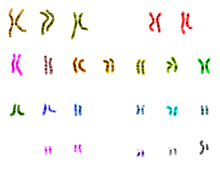Our website is made possible by displaying online advertisements to our visitors.
Please consider supporting us by disabling your ad blocker.
Genome
| Part of a series on |
| Genetics |
|---|
 |

A genome is all the genetic information of an organism.[1] It consists of nucleotide sequences of DNA (or RNA in RNA viruses). The nuclear genome includes protein-coding genes and non-coding genes, other functional regions of the genome such as regulatory sequences (see non-coding DNA), and often a substantial fraction of junk DNA with no evident function.[2][3] Almost all eukaryotes have mitochondria and a small mitochondrial genome.[2] Algae and plants also contain chloroplasts with a chloroplast genome.
The study of the genome is called genomics. The genomes of many organisms have been sequenced and various regions have been annotated. The first genome to be sequenced was that of the virus φX174 in 1977;[4] the first genome sequence of a prokaryote (Haemophilus influenzae) was published in 1995;[5] the yeast (Saccharomyces cerevisiae) genome was the first eukaryotic genome to be sequenced in 1996.[6] The Human Genome Project was started in October 1990, and the first draft sequences of the human genome were reported in February 2001.[7]
- ^ Roth, Stephanie Clare (1 July 2019). "What is genomic medicine?". Journal of the Medical Library Association. 107 (3). University Library System, University of Pittsburgh: 442–448. doi:10.5195/jmla.2019.604. ISSN 1558-9439. PMC 6579593. PMID 31258451.
- ^ a b Graur, Dan; Sater, Amy K.; Cooper, Tim F. (2016). Molecular and Genome Evolution. Sinauer Associates, Inc. ISBN 9781605354699. OCLC 951474209.
- ^ Brosius, J (2009). "The Fragmented Gene". Annals of the New York Academy of Sciences. 1178 (1): 186–93. Bibcode:2009NYASA1178..186B. doi:10.1111/j.1749-6632.2009.05004.x. PMID 19845638. S2CID 8279434.
- ^ Sanger F, Air GM, Barrell BG, Brown NL, Coulson AR, Fiddes CA, et al. (February 1977). "Nucleotide sequence of bacteriophage phi X174 DNA". Nature. 265 (5596): 687–95. Bibcode:1977Natur.265..687S. doi:10.1038/265687a0. PMID 870828. S2CID 4206886.
- ^ Fleischmann RD, Adams MD, White O, Clayton RA, Kirkness EF, Kerlavage AR, et al. (July 1995). "Whole-genome random sequencing and assembly of Haemophilus influenzae Rd". Science. 269 (5223): 496–512. Bibcode:1995Sci...269..496F. doi:10.1126/science.7542800. PMID 7542800. S2CID 10423613.
- ^ Goffeau A, Barrell BG, Bussey H, Davis RW, Dujon B, Feldmann H, Galibert F, Hoheisel JD, Jacq C, Johnston M, Louis EJ, Mewes HW, Murakami Y, Philippsen P, Tettelin H, Oliver SG (1996). "Life with 6000 genes". Science. 274 (5287): 546, 563–67. Bibcode:1996Sci...274..546G. doi:10.1126/science.274.5287.546. PMID 8849441. S2CID 16763139.
- ^ Olson MV (2002). "The Human Genome Project: A Player's Perspective". Journal of Molecular Biology. 319 (4): 931–942. doi:10.1016/S0022-2836(02)00333-9. PMID 12079320.
Previous Page Next Page


